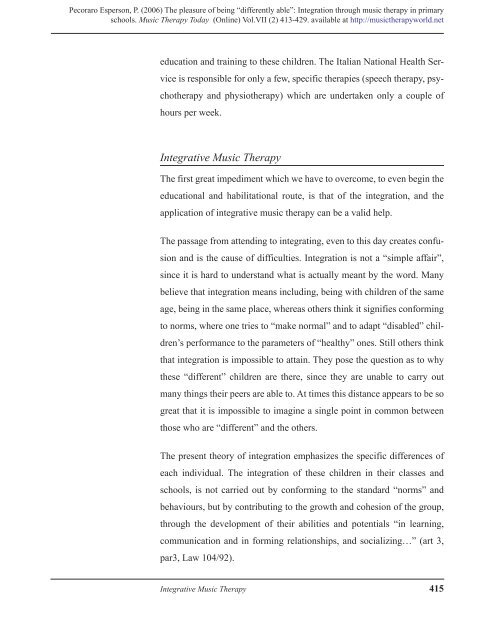Music Therapy Today - World Federation of Music Therapy
Music Therapy Today - World Federation of Music Therapy
Music Therapy Today - World Federation of Music Therapy
Create successful ePaper yourself
Turn your PDF publications into a flip-book with our unique Google optimized e-Paper software.
Pecoraro Esperson, P. (2006) The pleasure <strong>of</strong> being “differently able”: Integration through music therapy in primary<br />
schools. <strong>Music</strong> <strong>Therapy</strong> <strong>Today</strong> (Online) Vol.VII (2) 413-429. available at http://musictherapyworld.net<br />
education and training to these children. The Italian National Health Ser-<br />
vice is responsible for only a few, specific therapies (speech therapy, psy-<br />
chotherapy and physiotherapy) which are undertaken only a couple <strong>of</strong><br />
hours per week.<br />
Integrative <strong>Music</strong> <strong>Therapy</strong><br />
The first great impediment which we have to overcome, to even begin the<br />
educational and habilitational route, is that <strong>of</strong> the integration, and the<br />
application <strong>of</strong> integrative music therapy can be a valid help.<br />
The passage from attending to integrating, even to this day creates confu-<br />
sion and is the cause <strong>of</strong> difficulties. Integration is not a “simple affair”,<br />
since it is hard to understand what is actually meant by the word. Many<br />
believe that integration means including, being with children <strong>of</strong> the same<br />
age, being in the same place, whereas others think it signifies conforming<br />
to norms, where one tries to “make normal” and to adapt “disabled” chil-<br />
dren’s performance to the parameters <strong>of</strong> “healthy” ones. Still others think<br />
that integration is impossible to attain. They pose the question as to why<br />
these “different” children are there, since they are unable to carry out<br />
many things their peers are able to. At times this distance appears to be so<br />
great that it is impossible to imagine a single point in common between<br />
those who are “different” and the others.<br />
The present theory <strong>of</strong> integration emphasizes the specific differences <strong>of</strong><br />
each individual. The integration <strong>of</strong> these children in their classes and<br />
schools, is not carried out by conforming to the standard “norms” and<br />
behaviours, but by contributing to the growth and cohesion <strong>of</strong> the group,<br />
through the development <strong>of</strong> their abilities and potentials “in learning,<br />
communication and in forming relationships, and socializing…” (art 3,<br />
par3, Law 104/92).<br />
Integrative <strong>Music</strong> <strong>Therapy</strong> 415

















